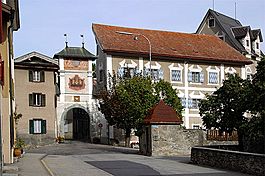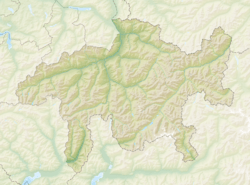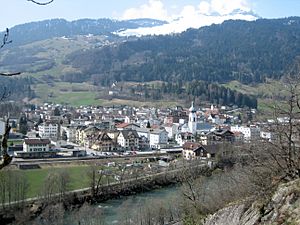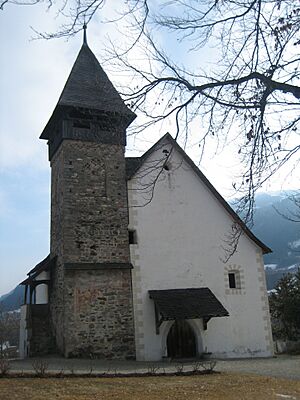Ilanz facts for kids
Quick facts for kids
Ilanz
|
||
|---|---|---|
 |
||
|
||
| Country | Switzerland | |
| Canton | Grisons | |
| District | Surselva | |
| Area | ||
| • Total | 4.50 km2 (1.74 sq mi) | |
| Elevation
(both churches)
|
699 m (2,293 ft) | |
| Population
(Dec 2011)
|
||
| • Total | 2,327 | |
| • Density | 517.1/km2 (1,339.3/sq mi) | |
| Postal code |
7130
|
|
| Surrounded by | Castrisch, Flond, Luven, Rueun, Ruschein, Schluein, Schnaus, Sevgein | |
Ilanz (Romansh: Glion) is a town in the Swiss canton of Grisons. It is located in the Surselva district. Ilanz used to be its own municipality.
On January 1, 2014, Ilanz joined with several nearby towns. These included Castrisch, Ladir, Luven, Pitasch, Riein, Ruschein, Schnaus, Sevgein, Duvin, Pigniu, Rueun, and Siat. Together, they formed the new municipality of Ilanz/Glion.
Contents
History of Ilanz
Ilanz was first mentioned in old writings in the year 765. It was called "Iliande" back then. In 1395, Ilanz became the main town of the new Grey League. This league was one of the groups that later formed the canton of Grisons. A person named Johannes von Ilanz, who was an abbot (a leader of a monastery), helped create this important alliance.
The Reformation in Ilanz
Ilanz played a special role in the Protestant Reformation. This was a time in the 1500s when many people changed how they practiced Christianity. In the 1520s, a big meeting called the Diet of Ilanz took place. At this meeting, it was decided that people in the Three Leagues could choose their own religion. They could be Catholic or follow the new Protestant ideas. This decision was very important for religious freedom in the area.
Geography of Ilanz
The town of Ilanz covers an area of about 4.7 square kilometers (1.8 square miles). A quarter of this land is used for farming. More than half of the area is covered by forests. About 18.7% of the land has buildings or roads. The rest is made up of rivers, glaciers, or mountains.
Ilanz is the first town along the Rhine River. Smaller streams come together here to form the main valley of the Vorderrhein. Ilanz is an important market town for the surrounding area. It has a train station, a supermarket, and the nearest hospital.
The town is located where the Surselva valley splits. This split is caused by Piz Mundaun, a mountain. From Ilanz, you can reach nearby villages like Ruschein and Ladir. You can also get to Vrin, Vals, and Obersaxen.
People of Ilanz
In 2011, Ilanz had a population of 2,327 people. About 15.4% of the people living there in 2008 were from other countries. Over the past 10 years, the population has grown a little.
Languages Spoken
Most people in Ilanz speak German (59.3%). The second most common language is Romansh (29.9%).
Age Groups
In 2000, about 9.9% of the population were children aged 0 to 9. Teenagers aged 10 to 19 made up 14.0% of the population.
Education and Jobs
Most adults in Ilanz (about 67.3%) have finished high school or gone on to higher education. The unemployment rate in Ilanz is low, at 1.44%.
In 2005, many people worked in different areas:
- 24 people worked in farming.
- 550 people worked in manufacturing and industry.
- 2,073 people worked in services, like shops or hospitals.
Religions
In 2000, most people in Ilanz were Roman Catholic (63.4%). About 22.6% belonged to the Swiss Reformed Church. Other religions included the Orthodox Church and Islam. Some people did not belong to any church.
Population Changes Over Time
The table below shows how the population of Ilanz has changed:
| year | population |
|---|---|
| 1835 | 574 |
| 1850 | 663 |
| 1900 | 981 |
| 1950 | 1,640 |
| 2000 | 2,488 |
This population count includes the nearby area of Strada.
Weather in Ilanz
Ilanz usually has rain for about 112.6 days each year. On average, it gets about 952 millimeters (37.5 inches) of rain. The wettest month is August, with about 102 millimeters (4 inches) of rain. June has the most rainy days, but with less rain overall. October is the driest month.
Important Heritage Sites
Two churches in Ilanz are very important historical buildings. They are the Church of St. Margreta and the Church of St. Martin. These are listed as Swiss heritage sites of national significance. This means they are protected because of their historical and cultural value.
Notable People from Ilanz
Many interesting people have come from Ilanz:
- Donat Cadruvi (1923–1998) was a lawyer and politician. He was also a writer in the Romansh language. He served as the Mayor of Ilanz from 1975 to 1978.
- Corina Casanova (born 1956) was the Federal Chancellor of Switzerland from 2008 to 2015. This is a very important government role.
- Serafin Wiestner (born 1990) is a Swiss biathlete. He is an athlete who competes in skiing and shooting. He took part in the 2014 Winter Olympics.
Sociology and Culture
An American university professor named Robert H. Billigmeier spent time in Ilanz. He was interested in different cultures. He wrote books about how different groups of people live together. His family had roots in Strada, which is now part of Ilanz/Glion.
See also
 In Spanish: Ilanz para niños
In Spanish: Ilanz para niños







